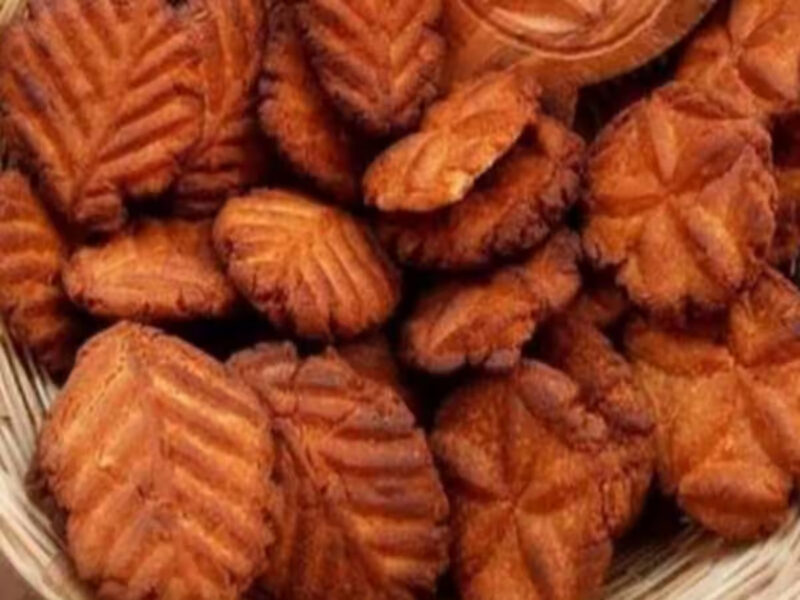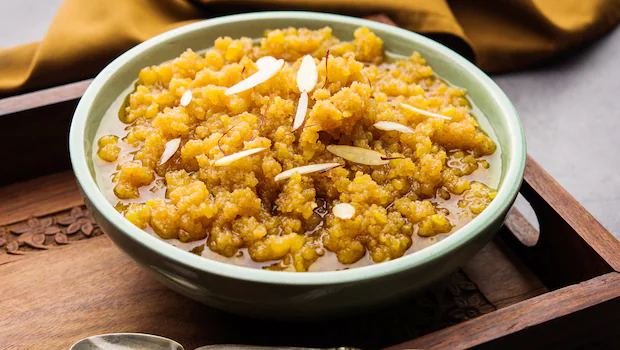Thekua Recipe: Thekua is a traditional sweet from the Eastern Indian states of Bihar and Jharkhand, often prepared during Chhath Puja, a festival dedicated to the Sun God (Surya Devta). These crunchy cookies, deep-fried to perfection, are a cherished family favorite, boasting flavors of fennel seeds and cardamom, complemented by the rich sweetness of jaggery.
Made primarily from whole wheat flour and jaggery, Thekua offers a delightful blend of textures—a crispy exterior giving way to a soft interior. Its rustic appearance, characterized by uneven cracked edges, adds to its charm and crunchiness. While traditional molds with leaf or round patterns are commonly used, alternatives like cookie presses or simple hand designs can also be employed.
As the colder weather sets in and the days grow shorter, the ritual of tea time gains even greater significance. Thekua serves as a perfect accompaniment to a steaming cup of chai, its crunchy texture making it an ideal dipping cookie.
Though similar in preparation and taste, it’s important to note that Thekua and Khajuri are distinct sweets. While Thekua is crafted from whole wheat flour and jaggery, Khajuri is made using all-purpose flour and sugar.
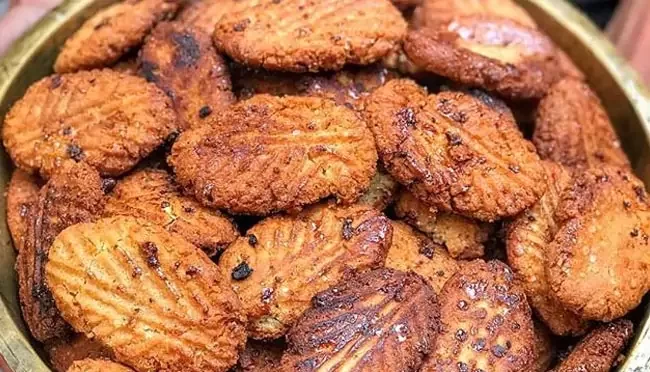
How to Make Thekua Recipe
Follow these step-by-step instructions with accompanying photos to easily and perfectly prepare Thekua every time.
In a mixing bowl, whisk together the following dry ingredients:
- 1.25 cups whole wheat flour (155 to 160 grams)
- 1 pinch of salt
- 1 teaspoon fennel seeds
- 1 tablespoon fresh grated coconut or desiccated coconut
- ½ teaspoon green cardamom powder
- Melt 3 tablespoons of ghee (25 grams) until hot.
- Pour the hot ghee into the dry ingredients.
- Mix the ghee with the dry ingredients using a spoon.
- Ensure that the mixture is warm or cool enough to handle, then continue mixing until you achieve a breadcrumb-like consistency. When pressed, the mixture should form a lump and not fall apart.
- In a small saucepan, mix ½ cup chopped jaggery (85 grams) with ¼ cup water.
- Heat the mixture on medium-low heat until all the jaggery melts, creating a dark caramel-colored syrup.
- Pour the hot jaggery solution into the flour mixture in small batches, adding a few tablespoons at a time.
- Mix the jaggery solution with the flour using a spoon.
- Gradually add the remaining jaggery solution, mixing continuously until all the liquid has been incorporated.
- Once all the jaggery solution has been added, continue mixing to bring the entire dough together and knead lightly. Avoid overworking the dough.
- Form the dough into a firm or semi-soft ball, then cover it with a lid or kitchen towel and let it rest for 15 minutes.
- If the dough becomes sticky, add some flour and mix. If it appears dry or crumbly, add a little water and combine with the dough.
- Now, your Thekua dough is ready to be shaped and fried into delicious, crispy cookies.

Shape the Dough
- Divide the dough into small balls. You can use a small scoop or ice cream scoop for even portions.
- Lightly flatten each ball with your palms or a rolling pin.
- Create patterns on the flattened dough using a fork, toothpick, or bamboo skewer.
- Get creative with your patterns!
- Alternatively, use a Peda maker, cookie press, or cookie stamps to shape the dough. Keep the shaped discs covered with a kitchen napkin until ready to fry to prevent them from drying out.
Fry the Thekua
- Heat 1.5 cups of oil in a kadai or wok. Test the oil’s temperature by dropping a small piece of dough into it. If it rises gradually to the top, the oil is ready. Lower the heat to low or medium-low before adding the thekua to avoid overcrowding the oil.
- Gently place the thekua in the hot oil. Fry until one side is golden brown, then carefully flip and fry the other side. Be gentle when turning to prevent breakage. Fry until both sides are golden and crisp.
- Remove the fried thekua and place them on kitchen paper towels to drain excess oil. Fry the remaining shaped cookies in batches until golden and crisp. Once cooled to room temperature, store the thekua in an airtight container.
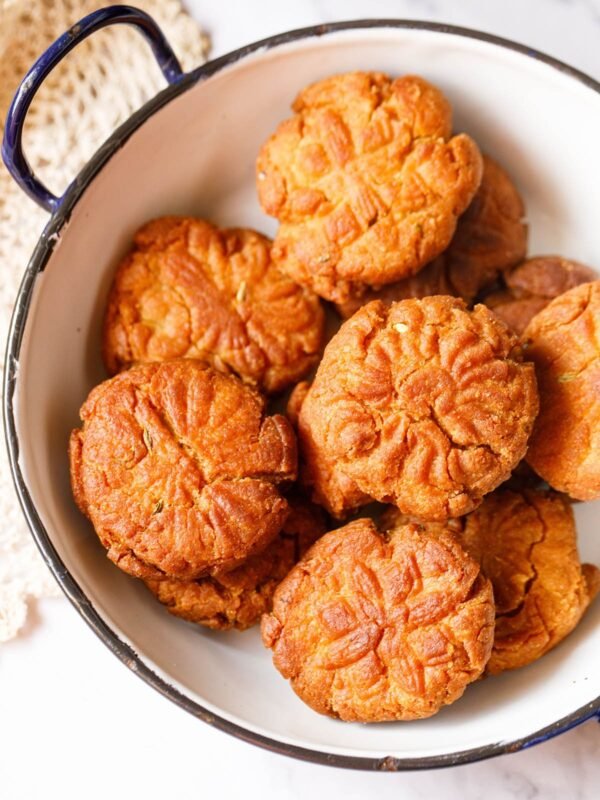
Storage Recommendations
- Always store these Indian cookies in an airtight jar or container. They can be kept at room temperature for about a week. Alternatively, you can store them in the refrigerator.
- If you’ve made thekua with milk, store them in an airtight container in the refrigerator.
Thekua Recipe Ingredient Variations
- Liquids: You can easily replace water with milk. Using milk makes a richer version of thekua.
- Jaggery: If you’re unable to find jaggery, you can substitute it with dark brown sugar, light brown sugar, granulated white sugar, raw sugar, or even molasses. Keep in mind that the unique flavor of jaggery will be absent in the final product.
- Coconut: You can use either dry desiccated coconut or fresh grated coconut. If unavailable, you can choose to omit it.
- Spices: Both fennel seeds and cardamom powder are essential spices and should not be omitted.
- Flour: For a lighter and more tender variation of thekua, you can use all-purpose flour (maida) or an equal mix of whole wheat flour and all-purpose flour. However, note that when using all-purpose flour, you may need to reduce the amount of water added to the dough.
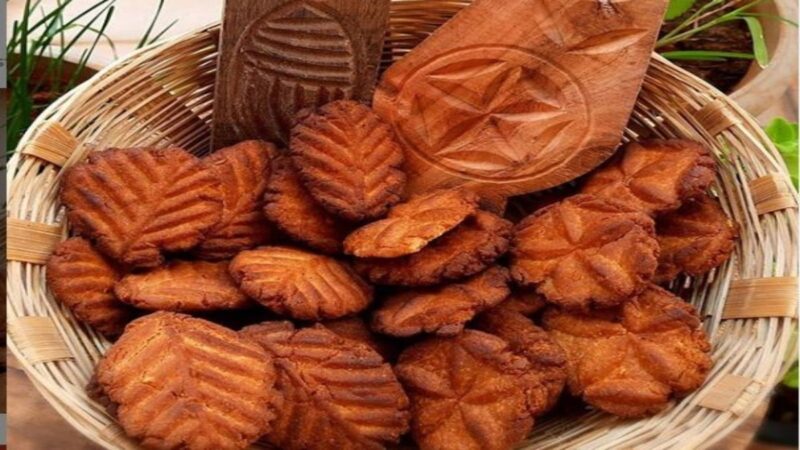
Thekua Recipe Dough Troubleshooting Tips
- The ideal dough should have a slight elasticity, falling somewhere between semi-soft and firm.
- If your dough appears crumbly and dry, add a few tablespoons of water, then mix and lightly knead again.
- If your dough becomes sticky or too soft, add a few tablespoons of flour, then combine it with the remaining dough by mixing and lightly kneading.
Why are my thekua turning too dark?
- Thekua should ideally have a beautiful golden brown color when cooked perfectly. Before starting to fry, aim for a temperature between 180°C to 190°C (360°F to 375°F), which can be easily checked using a deep fry or candy thermometer.
- If you don’t have a thermometer on hand, there are three ways to check the temperature:
- Firstly, drop a small piece of dough into the oil. If it gradually rises to the surface and starts bubbling, the oil is ready.
- Secondly, you can drop a small piece of bread into the oil. If it turns golden brown in about 60 seconds, the temperature is right. If the bread remains pale, the oil needs more time to heat. If it darkens too quickly, the oil is too hot and needs to cool down.
- Thirdly, you can drop a popcorn kernel into the oil as it heats. The kernel will pop at around 180°C/360°F, indicating that the oil is close to the right temperature.
- Avoid frying at high heat as the thekua will darken too quickly on the outside while the inside remains uncooked. Fry them at low or medium-low heat.
- Turn the thekua only when one side is golden brown, and do it gently. These cookies are delicate, so take care when handling them during frying.
- To flip the thekua, you can use two chopsticks or a spider skimmer to gently turn them in the oil.
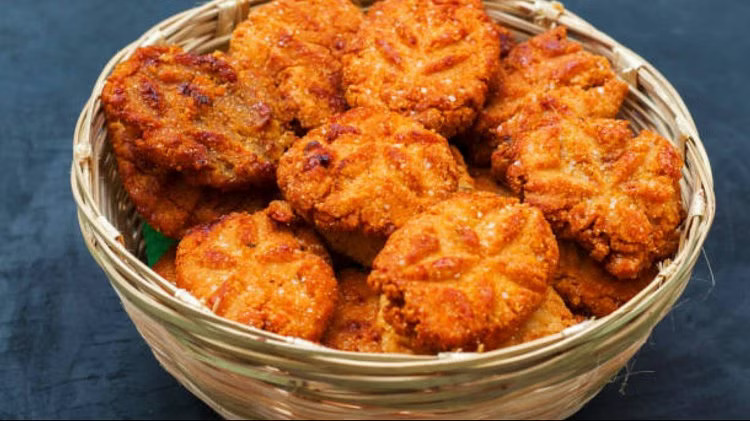
What is Jaggery and where can I find it?
- Jaggery is an unrefined cane sugar made by boiling sugarcane (or sometimes date palm) juice in large metal vats.
- It goes by various names depending on your region – piloncillo or panela in Latin America, rapadura and chancaca in South America, and nam oy in Laos, among others.
- The boiled sugarcane juice leaves behind a solid deposit, which is usually sold in blocks or cones. While ground jaggery is available, it’s not recommended.
- Jaggery has a more complex flavor compared to brown sugar, which is typically a mix of granulated sugar and molasses. It offers earthy, caramel, and smoky undertones, making it a unique and delightful ingredient for sweets.
- Jaggery is commonly found in Indian markets. If you’re abroad, you can usually find it at international or Indian specialty stores, as well as Latin supermarkets.
- You can also purchase jaggery online, although the price may be higher compared to buying it from a regular grocery store.
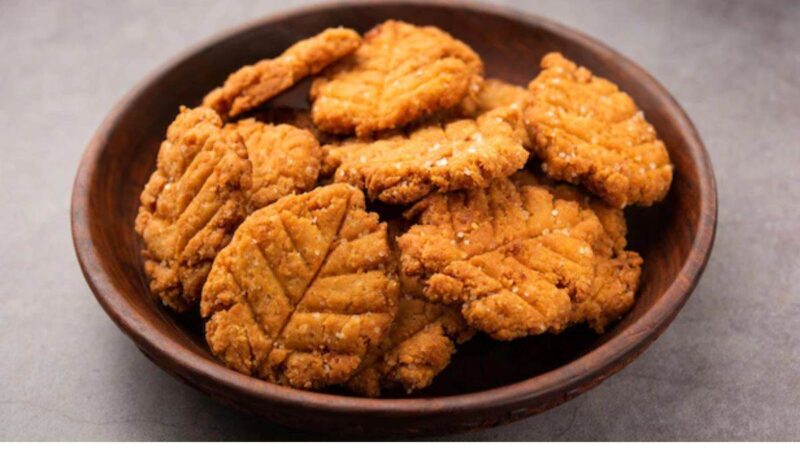
Conclusion:
Thekua Recipe, a traditional sweet from Eastern Indian states, is a beloved treat during festivals like Chhath Puja. With its crunchy texture and rich flavors of fennel seeds, cardamom, and jaggery, it’s a delightful accompaniment to tea. By following the provided recipe and troubleshooting tips, you can create perfect batches of thekua every time, ensuring a delicious treat for family and friends
FAQs about Thekua Recipe
Why are my thekua turning too dark?
Thekua should ideally have a beautiful golden brown color when cooked perfectly. Before starting to fry, aim for a temperature between 180°C to 190°C (360°F to 375°F). Avoid frying at high heat as they will darken too quickly on the outside while remaining uncooked inside. Fry them at low or medium-low heat.
What is Jaggery and where can I find it?
Jaggery is an unrefined cane sugar made by boiling sugarcane juice. It has a complex flavor with earthy, caramel, and smoky undertones. You can find jaggery in Indian markets, international or Indian specialty stores, as well as online.
Can I use all-purpose flour instead of whole wheat flour?
Yes, you can use all-purpose flour for a lighter and more tender variation of thekua. However, note that you may need to adjust the amount of water added to the dough.
How should I store thekua?
Always store thekua in an airtight container. They can be kept at room temperature for about a week or stored in the refrigerator, especially if made with milk.
Can I make variations to the ingredients?
Yes, you can make variations. You can replace water with milk for a richer version, substitute jaggery with brown sugar or molasses, use either dry desiccated coconut or fresh grated coconut, and adjust the spices according to your preference.

